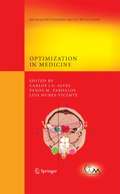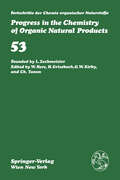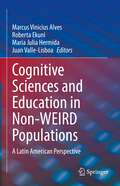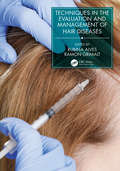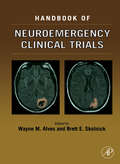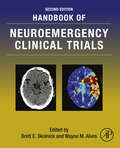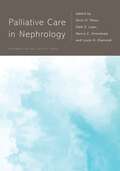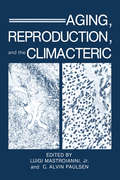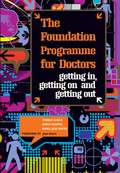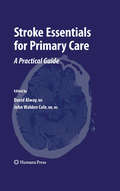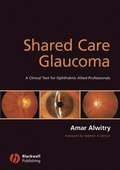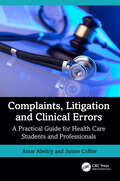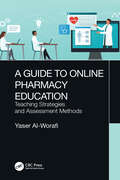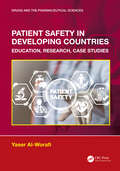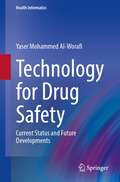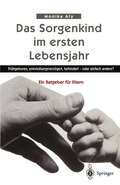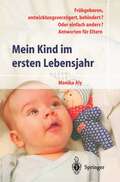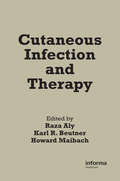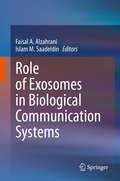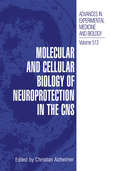- Table View
- List View
Optimization in Medicine (Springer Optimization and Its Applications #12)
by Carlos J. S. Alves Panos M. Pardalos Luis Nunes VicenteThis volume presents a wide range of medical applications that can utilize mathematical computing. This work grew out of a workshop on optimization which was held during the 2005 CIM Thematic Term on Optimization in Coimbra, Portugal. It provides an overview of the state-of-the-art in optimization in medicine and will serve as an excellent reference for researchers in the medical computing community and for those working in applied mathematics and optimization.
Fortschritte der Chemie organischer Naturstoffe / Progress in the Chemistry of Organic Natural Products (Fortschritte der Chemie organischer Naturstoffe Progress in the Chemistry of Organic Natural Products #53)
by L. F. Alves A. Chimiak M. J. Milewska T. NomuraThe volumes in this classic series, now referred to simply as "Zechmeister" after its founder, L. Zechmeister, have appeared under the Springer Imprint ever since the series' inauguration in 1938. The volumes contain contributions on various topics related to the origin, distribution, chemistry, synthesis, biochemistry, function or use of various classes of naturally occuring substances ranging from small molecules to biopolymers. Each contribution is written by a recognized authority in this field and provides a comprehensive and up-to-date review of the topic in question. Addressed to biologists, technologists and chemists alike, the series can be used by the expert as a source of information and literature citations and by the non-expert as a means of orientation in a rapidly developing discipline.
Cognitive Sciences and Education in Non-WEIRD Populations: A Latin American Perspective
by Marcus Vinicius Alves Roberta Ekuni Maria Julia Hermida Juan Valle-LisboaThis book aims to present theoretical and practical innovations in the cognitive sciences and education fields focusing on studies and research conducted with non-WEIRD (i.e., western, educated, industrialized, rich and democratic) populations, especially from Latin America. Cognitive sciences and neuroscience have increased exponentially their knowledge in the last three decades, and today there is a corpus of knowledge about our central nervous system and its functioning that (adequately understood) has promising contributions for the educational field. Most of this knowledge, however, comes from central countries (North America, Europe) and is based on studies conducted on what has been called WEIRD populations. Much less is known about how the integration of cognitive sciences and neuroscience could impact education in non-WEIRD populations, which represent the great majority of the world’s population and have quite diverse cultural and social characteristics. So, the main aim of this book is to present a non-WEIRD scientific approach to problems in the cognitive sciences, neuroscience and education fields.Research presented in this contributed volume takes advantage of the diverse populations that characterize developing countries to explore how underrepresented populations learn, what works and what does not for cognitive science and education not only for the developing world, but also for understanding diversity in the whole world. Departing from this focus on diversity, chapters in this book present studies on theories, beliefs and misconceptions about the relationship between cognitive sciences and education; child and adolescent cognitive development; mathematics and language academic performance; and cognitive interventions to improve educational practice. Cognitive Sciences and Education in Non-WEIRD Populations: A Latin American Perspective will be a useful resource for both cognitive scientists and educational researchers interested in developing a more culturally sensitive approach to basic and applied research on cognitive sciences of education.
Techniques in the Evaluation and Management of Hair Diseases (Series in Dermatological Treatment)
by Rubina Alves Ramon GrimaltThis book covers the aspects that will help someone starting a practice focused on hair disease or more senior practitioners needing an update on developments. World experts have here generously supplied the information needed, in an extremely practical way, to properly manage daily practice when treating hair patients. Published in association with the Journal of Dermatological Treatment.
Techniques in the Evaluation and Management of Hair Diseases (Series in Dermatological Treatment)
by Rubina Alves Ramon GrimaltThis book covers the aspects that will help someone starting a practice focused on hair disease or more senior practitioners needing an update on developments. World experts have here generously supplied the information needed, in an extremely practical way, to properly manage daily practice when treating hair patients. Published in association with the Journal of Dermatological Treatment.
Handbook of Neuroemergency Clinical Trials
by Wayne M. Alves Brett E. SkolnickDuring the 1990’s, scientific advances in understanding the mechanisms and pathophysiology of acute central nervous system injury were offset by a history of disappointing results from Phase III clinical trials of novel neuroprotective drugs. Numerous novel compounds were “tested," and seemingly fell by the wayside. This book is intended to focus on novel therapies and the unique challenges their intended targets pose for the design and analysis of clinical trials. The authors explore the issues facing research in this area and the strategies that might lead to future success in this critical area of unmet medical need. It represents a compendium of information gained from over 20 years of clinical trial experience in areas of acute neurology and neurosurgery. From the knowledge of clinical assessment using standardized tools, to the intricate design of difficult hyper-acute neuroemergencies trials, the reader will benefit from the authors’ perspectives.* Presents new perspectives on acute neuroemergency clinical trials * Includes insights from clinical pharmacology and industry perspectives* Discusses historical lessons learned from early and recent trials in acute neuroscience populations
Handbook of Neuroemergency Clinical Trials
by Wayne M. Alves Brett E. SkolnickHandbook of Neuroemergency Clinical Trials, Second Edition, focuses on the practice of clinical trials in acute neuroscience populations, or what have been called neuroemergencies. Neuroemergencies are complex, life-threatening diseases and disorders, often with devastating consequences, including death or disability. The overall costs are staggering in terms of annual incidence and costs associated with treatment and survival, yet despite their significance as public health issues, there are few drugs and devices available for definitive treatment. The book focuses on novel therapies and the unique challenges their intended targets pose for the design and analysis of clinical trials. This volume provides neurologists, neuroscientists, and drug developers with a more complete understanding of the scientific and medical issues of relevance in designing and initiating clinical development plans for novel drugs intended for acute neuroscience populations. The editors provide the best understanding of the pitfalls associated with acute CNS drug development and the best information on how to approach and solve issues that have plagued drug development. Presents a comprehensive overview on clinical trials and drug development challenges in acute neuroscience populations Provides neurologists, neuroscientists and drug developers with a complete understanding of scientific and medical issues related to designing clinical trials Edited by leaders in the field who have designed and managed over 50 neuroemergency clinical trials
Palliative Care in Nephrology (Integrating Palliative Care)
by Alvin H. Moss, MD, Dale E. Lupu, MPH, PhD, Nancy C. Armistead, MPA and Louis H. Diamond, MD, FCPPalliative care has become increasingly important across the spectrum of healthcare, and with it, the need for education and training of a broad range of medical practitioners not previously associated with this field of care. As part of the Integrating Palliative Care series, this volume on palliative care in nephrology guides readers through the core palliative knowledge and skills needed to deliver high value, high quality care for seriously ill patients with chronic and end-stage kidney disease. Chapters are written by a team of international leaders in kidney palliative care and are organized into sections exploring unmet supportive care needs, palliative care capacity, patient-centered care, enhanced support at the end of life, and more. Chapter topics are based on the Coalition for Supportive Care of Kidney Patients Pathways Project change package of 14 evidence-based best practices to improve the delivery of palliative care to patients with kidney disease. An overview of the future of palliative care nephrology with attention to needed policy changes rounds out the text. Palliative Care in Nephrology is an ideal resource for nephrologists, nurses, nurse practitioners, physician assistants, social workers, primary care clinicians, and other practitioners who wish to learn more about integrating individualized, patient-centered palliative care into treatment of their patients with kidney disease.
Aging, Reproduction, and the Climacteric
by C. AlvinPaulsen LuigiMastroianniInterest in sexuality and reproductive function does not cease when people begin to age. Instead, a new set of questions arises. Women want to know if it is safe to have babies in their late thirties and early forties. They want to know more about hot flashes and other symptoms of menopause-which ones are dangerous and which are merely uncomfortable. They are eager to learn about the relative risks and benefits of estrogen replacement therapy. Men, too, are concerned about age-related changes in their sexual function. Experts in reproductive physiology, gerontology, and genetics met at the National Institutes of Health in June of 1984 to discuss these and other concerns about aging and the reproductive system. The conference on Aging, Reproduc tion, and the Climacteric was sponsored by the American Fertility Society, The National Institute on Aging, and the National Institute of Child Health and Human Development. This volume is based on the proceedings of that confer ence.
The Foundation Programme for Doctors: Getting in, Getting on and Getting Out
by Ferras Alwan Rohin Francis Emma Jane SmithThis book includes a foreword by Jane Dacre, Academic Vice President, Royal College of Physicians, Professor of Medical Education, CHIME, Royal Free and University College Medical School, University College London, Consultant Physician and Rheumatologist, The Whittington Hospital, London. This book prepares you for the often daunting life after medical school, detailing everything you need to know about preparing, applying and surviving. It's the most up-to-date guide available filling you in on recent important changes to the application system. This practical guide is full of valuable tips, tables, worked examples, frequently asked questions, further resources and useful addresses. Highly recommended for final year medical students and other clinical medical students preparing for their final year, this book is also invaluable for junior doctors progressing through the Foundation Programme and all those with teaching and supervisory responsibilities in medical schools and hospitals. 'An invaluable resource for our new generation of doctors. It takes readers through the process from application, to F2 and beyond. It offers useful advice in a useable and readable format. It is written by a group of current and past medical students who have lived through, and continue to live through, the insecurities of the changing medical career structures. Its style is informal, engaging and easy to absorb, so it should be a good distraction for those currently in the run-up to their finals exams. Good luck to all of you, and don't forget, Medicine is a wonderful career.' - Jane Dacre, in the Foreword.
The Foundation Programme for Doctors: Getting in, Getting on and Getting Out (Radcliffe Ser.)
by Ferras Alwan Rohin Francis Emma Jane SmithThis book includes a foreword by Jane Dacre, Academic Vice President, Royal College of Physicians, Professor of Medical Education, CHIME, Royal Free and University College Medical School, University College London, Consultant Physician and Rheumatologist, The Whittington Hospital, London. This book prepares you for the often daunting life after medical school, detailing everything you need to know about preparing, applying and surviving. It's the most up-to-date guide available filling you in on recent important changes to the application system. This practical guide is full of valuable tips, tables, worked examples, frequently asked questions, further resources and useful addresses. Highly recommended for final year medical students and other clinical medical students preparing for their final year, this book is also invaluable for junior doctors progressing through the Foundation Programme and all those with teaching and supervisory responsibilities in medical schools and hospitals. 'An invaluable resource for our new generation of doctors. It takes readers through the process from application, to F2 and beyond. It offers useful advice in a useable and readable format. It is written by a group of current and past medical students who have lived through, and continue to live through, the insecurities of the changing medical career structures. Its style is informal, engaging and easy to absorb, so it should be a good distraction for those currently in the run-up to their finals exams. Good luck to all of you, and don't forget, Medicine is a wonderful career.' - Jane Dacre, in the Foreword.
Stroke Essentials for Primary Care: A Practical Guide (Current Clinical Practice)
by David Alway John Walden ColeStroke Essentials for Primary Care: A Practical Guide is a must-have resource, offering the essential, practical knowledge required to evaluate and treat stroke patients. While an indispensable guide for primary care clinicians, including family practitioners and medical internists who often assume the care of stroke patients without the aid of a neurologist (primarily in underserved areas), the information contained herein is also an invaluable resource to all physicians in training, especially residents and fellows in neurology, cardiology, and surgery, among others. Stroke Essentials for Primary Care: A Practical Guide provides the latest diagnostic and treatment information that allows for greater clinical confidence. Designed to allow easy access to essential information, most chapters include a quick summary of their content and conclusions. Chapters review information on such topics as distinguishing features of presentation, rapid determination of stroke type, prevention strategies, long-term complications, and special topics that may apply to specific populations. Targeted and easy to read, Stroke Essentials for Primary Care: A Practical Guide is an essential resource for all practitioners in primary care medicine and specialty physicians in training.
Shared Care Glaucoma
by Amar AlwitryShared Care Glaucoma provides concise, clear and user-friendly information for the non-ophthalmologist caring for glaucoma patients. It would also be an ideal text for ophthalmic trainees learning about glaucoma management and for generalist ophthalmologists who want to refresh their approach to their glaucoma care. The book covers the aetiology, classification, diagnosis and management of glaucoma under the four key sections: About Glaucoma, Detecting Progression, Treating Glaucoma and Specific Glaucoma Entities, enabling the reader to comfortably manage glaucoma patients and offering guidance on when they should refer, and to whom. Frequently asked questions are anticipated and logical responses given, supported by evidence from recent literature. That there are often no clear right and wrong decisions within many individual’s glaucoma management plan is well recognised and conveyed.
Complaints, Litigation and Clinical Errors: A Practical Guide for Health Care Students and Professionals
by Amar Alwitry Janine CollierThis concise book provides readers with practical guidance to help them to both avoid errors and develop robust processes to protect themselves and their patients, as well as dealing appropriately with complaints and litigation, when things do go wrong. Free of complex legal terminology, the book outlines key concepts in medical law and how these may be applied to clinical situations in both hospital and community settings.Key Features· Accessible text addressing these specific areas of concern for all health care students and practitioners – error and harm, complaints, negligence claims and litigation· Supported throughout with case examples, accompanied by commentaries from experienced clinical specialists· Both medical and legal perspectives are reflected in the experienced editor teamIncorporating case law with practical studies, legal information is supplemented by clinical commentaries from a range of specialists representing the perspective of the health care practitioner. The book is essential reading for medical and health students, practising clinicians and allied health care professionals at all levels.
Complaints, Litigation and Clinical Errors: A Practical Guide for Health Care Students and Professionals
by Amar Alwitry Janine CollierThis concise book provides readers with practical guidance to help them to both avoid errors and develop robust processes to protect themselves and their patients, as well as dealing appropriately with complaints and litigation, when things do go wrong. Free of complex legal terminology, the book outlines key concepts in medical law and how these may be applied to clinical situations in both hospital and community settings.Key Features· Accessible text addressing these specific areas of concern for all health care students and practitioners – error and harm, complaints, negligence claims and litigation· Supported throughout with case examples, accompanied by commentaries from experienced clinical specialists· Both medical and legal perspectives are reflected in the experienced editor teamIncorporating case law with practical studies, legal information is supplemented by clinical commentaries from a range of specialists representing the perspective of the health care practitioner. The book is essential reading for medical and health students, practising clinicians and allied health care professionals at all levels.
A Guide to Online Pharmacy Education: Teaching Strategies and Assessment Methods
by Yaser Al-WorafiThis book describes in detail the various teaching strategies and assessment methods used in pharmacy education. Included in the text is both the advantages and disadvantages of each teaching and assessment method, as well as tips for effective implementation of the strategies. The text covers a plethora of teaching styles, from web based and online learning to lecture and team-based learning, and highlights some of the best practices used worldwide. This book aims to be a valuable single resource for pharmacy educators, students, and researchers. Key features One resource for the pharmacy educators, students, partitioners, researchers, policy makers and other readers with the necessary information and practical guidelines about the online pharmacy education, practice, and research. Describe and discuss the situation of the online pharmacy education, practice, and research around the world. Describe the challenges facing the online pharmacy education, practice, and research and suggest recommendations to overcome the challenges. Describe the pharmacy education teaching strategies and assessment methods. Describe the advantages and disadvantages of each teaching strategy and assessment method. Provide tips for the effective implementation of teaching strategies and assessment methods based on the best practices worldwide.
A Guide to Online Pharmacy Education: Teaching Strategies and Assessment Methods
by Yaser Al-WorafiThis book describes in detail the various teaching strategies and assessment methods used in pharmacy education. Included in the text is both the advantages and disadvantages of each teaching and assessment method, as well as tips for effective implementation of the strategies. The text covers a plethora of teaching styles, from web based and online learning to lecture and team-based learning, and highlights some of the best practices used worldwide. This book aims to be a valuable single resource for pharmacy educators, students, and researchers. Key features One resource for the pharmacy educators, students, partitioners, researchers, policy makers and other readers with the necessary information and practical guidelines about the online pharmacy education, practice, and research. Describe and discuss the situation of the online pharmacy education, practice, and research around the world. Describe the challenges facing the online pharmacy education, practice, and research and suggest recommendations to overcome the challenges. Describe the pharmacy education teaching strategies and assessment methods. Describe the advantages and disadvantages of each teaching strategy and assessment method. Provide tips for the effective implementation of teaching strategies and assessment methods based on the best practices worldwide.
Patient Safety in Developing Countries: Education, Research, Case Studies (Drugs and the Pharmaceutical Sciences)
by Yaser Al-WorafiUnderstanding the various aspects of patient safety education, practice, and research in developing countries is vital in preparing a plan to overcome the challenges of improving patient safety. This unique volume discusses patient safety in developing countries, and the achievements and challenges faced in those places when trying to improve patient safety education and practice.This book includes a compilation of over 100 case studies surrounding patient safety in all aspects of health care. Both real and simulated scenarios are provided to help medical students and professionals apply their knowledge to solve the cases and prepare for real practice. Features Describes the achievements and challenges of patient safety in developing countries. Includes real and simulated case studies and key answers on patient safety issues. Prepares medical students and practitioners for real-life situations. Diverse audience including those in medication to safety testing, patient education, dispensing changes, and the design of health systems. Aids medical students and practitioners to improve their skills to solve cases.
Patient Safety in Developing Countries: Education, Research, Case Studies (Drugs and the Pharmaceutical Sciences)
by Yaser Al-WorafiUnderstanding the various aspects of patient safety education, practice, and research in developing countries is vital in preparing a plan to overcome the challenges of improving patient safety. This unique volume discusses patient safety in developing countries, and the achievements and challenges faced in those places when trying to improve patient safety education and practice.This book includes a compilation of over 100 case studies surrounding patient safety in all aspects of health care. Both real and simulated scenarios are provided to help medical students and professionals apply their knowledge to solve the cases and prepare for real practice. Features Describes the achievements and challenges of patient safety in developing countries. Includes real and simulated case studies and key answers on patient safety issues. Prepares medical students and practitioners for real-life situations. Diverse audience including those in medication to safety testing, patient education, dispensing changes, and the design of health systems. Aids medical students and practitioners to improve their skills to solve cases.
Technology for Drug Safety: Current Status and Future Developments (Health Informatics)
by Yaser Mohammed Al-WorafiThis book presents information about the use of technology to support the prevention and management of drug safety issues: pharmacovigilance (PV), medication errors, drug-related problems (DRPs), counterfeit medicines and other drug safety issues. Adapting new technologies/information technologies, mobile technologies and social media has contributed effectively to safety practices for medications, with this book providing comprehensive information as a guide to its challenges and potential. Technology for Drug Safety provides practicing and trainee pharmacists, pharmacy technicians, pharmacy educators, researchers, public health policy makers, healthcare professionals and medical educators with vital information about the impact of technology on drug safety-related issues. It describes the current status of the practice, the challenges in the field and recommendations for the effective use of technology in drug safety practice including clinical trials and drug development, PV, detection of adverse drug reactions, reporting and management, medication errors detection, reporting and management, DRPs, counterfeit and substandard medications, and other safety issues.
Das Sorgenkind im ersten Lebensjahr: Frühgeboren, entwicklungsverzögert, behindert — oder einfach anders? Ein Ratgeber für Eltern (Hilfe zur Selbsthilfe)
by Monika AlyEltern mit einem "Risikokind" stehen häufig vor der Frage, ob ihr Kind tatsächlich behindert oder nur vorübergehend in seiner Entwicklung verzögert ist. Der Ratgeber informiert verständlich über alle wichtigen medizinischen Fakten und Therapie-Angebote. Er bietet Eltern und Betreuern praktische Orientierungshilfe, um die nötigen Therapie-Entscheidungen umsichtig und zum richtigen Zeitpunkt zu treffen.
Mein Kind im ersten Lebensjahr: Frühgeboren, entwicklungsverzögert, behindert? Oder einfach anders? Antworten für Eltern (Hilfe zur Selbsthilfe)
by Monika AlyHaben Sie das Gefühl, dass bei Ihrem Baby "etwas" nicht stimmt? Vielleicht hat es einfach die Folgen seiner zu frühen Geburt noch nicht verkraftet; vielleicht beobachten Sie aber Anzeichen, die auf eine schwer wiegende Entwicklungsstörung hinweisen. Als Eltern sind Sie in einer schwierigen Situation: Aus Sorge um Ihr Kind suchen Sie Rat bei Fachärzten und Therapeuten, aber deren Vorhersagen und Diagnosen bleiben in den ersten Lebensmonaten oft unklar. Die Besorgnis erregenden Anzeichen können im Lauf des 1. Lebensjahrs verschwinden - sie können sich aber auch verstärken. Sie fühlen sich in Ihrer elterlichen Verantwortung überfordert, lassen sich vielleicht zu vorschnellen Frühfördermaßnahmen drängen und verlieren Ihre intuitive Sicherheit im Umgang mit dem Kind. Das Buch von Monika Aly möchte Sie mit sachlicher Information und praktischem Rat darin unterstützen, die für Ihr Kind richtigen Entscheidungen zu treffen.
Cutaneous Infection and Therapy
by Raza AlyThis unique reference provides concise, single-source coverage of the clinical, research, and therapeutic aspects of dermatological problems associated with bacteria, fungi, and viruses.Introduces many novel antifungal, antibacterial, and antiviral agents!Highlighting the molecular biology as well as risk - benefit ratios of new diagnostic
Role of Exosomes in Biological Communication Systems
by Faisal A. Alzahrani Islam M. SaadeldinThis book reviews the role of exosomes and extracellular vesicles in both normal and pathological conditions. It first explains isolation methods for exosomes, and analyzes their fine structure and biological functions. Further, it highlights exosomes’ role as the key regulator in embryonic-maternal communication, and in the pathogenesis of various diseases, including cancer and urogenital, infectious, and neurodegenerative diseases. Moreover, it reviews the latest advances in using stem-cell-derived exosomes as a cell-free strategy in regenerative medicine, as well as the potential of exosomal microRNA as a promising non-invasive biomarker and targetable factor in cancer diagnosis and treatment. Lastly, it explores the use of natural and synthetic exosomes as nano-vehicles for efficient drug delivery.
Molecular and Cellular Biology of Neuroprotection in the CNS (Advances in Experimental Medicine and Biology #513)
by Christian AlzheimerGiven the very limited capacity of regeneration in the brain, protecting neurons that are on the brink of death is a major challenge for basic and clinical neuroscience, with implications for a broad spectrum of acute and chronic neurological and psychiatric diseases. This book brings together leading experts from neurobiology, neurophysiology, neuropharmacology, neuroimmunology and clinical neuroscience to highlight the most recent milestones in this rapidly evolving field. The book will serve as a reference for both basic neuroscientists and clinicians interested in an authoritative update on the molecular and cellular biology of neuroprotection and its promises for new therapeutic strategies.
